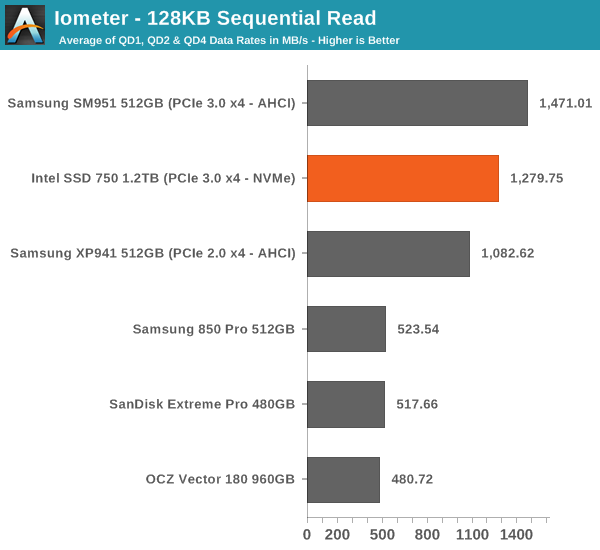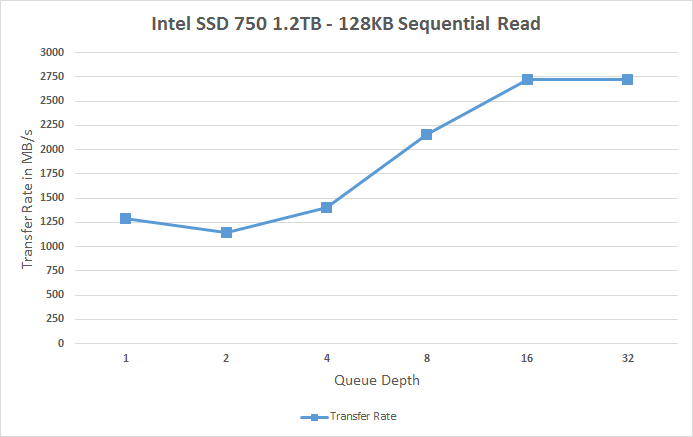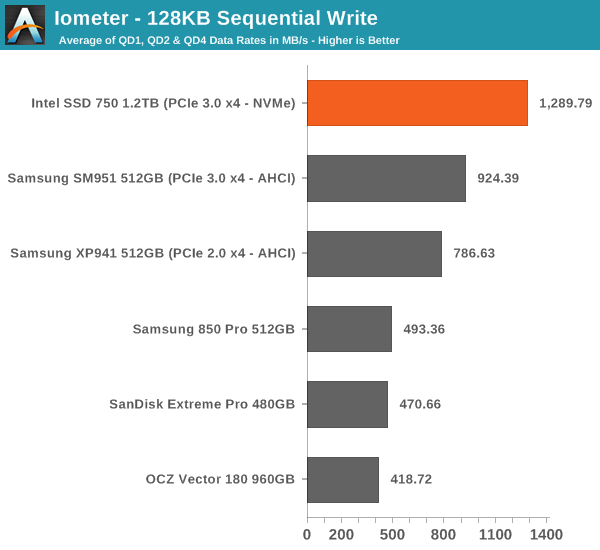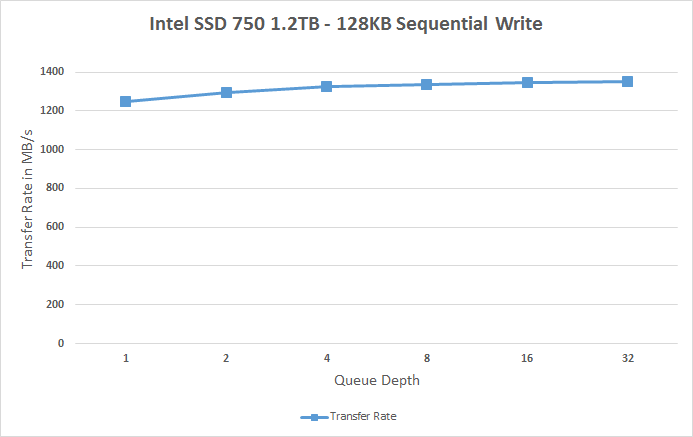Intel SSD 750 PCIe SSD Review: NVMe for the Client
by Kristian Vättö on April 2, 2015 12:00 PM ESTSequential Read Performance
Our sequential tests are conducted in the same manner as our random IO tests. Each queue depth is tested for three minutes without any idle time in between the tests and the IOs are 4K aligned similar to what you would experience in a typical desktop OS.

In sequential read performance the SM951 keeps its lead. While the SSD 750 reaches up to 2.75GB/s at high queue depths, the scaling at small queue depths is very poor. I think this is an area where Intel should have put in a little more effort because it would translate to better performance in more typical workloads.
 |
|||||||||
Sequential Write Performance
Sequential write testing differs from random testing in the sense that the LBA span is not limited. That's because sequential IOs don't fragment the drive, so the performance will be at its peak regardless.

The SSD 750 is faster in sequential writes than the SM951, but the difference isn't all that big when you take into account that the SSD 750 has more than twice the amount of NAND. The SM951 did have some throttling issues as you can see in the graph below and I bet that with a heatsink and proper cooling the two would be quite identical because at queue depth of 1 the SSD 750 is only marginally faster. It's again a bit disappointing that the SSD 750 isn't that well optimized for sequential IO because there's prcatically no scaling at all and the drive maxes out at ~1350MB/s.
 |
|||||||||










132 Comments
View All Comments
mmrezaie - Thursday, April 2, 2015 - link
finally it has started, although I wont budge now. maybe next generation.blanarahul - Thursday, April 2, 2015 - link
Hey Kristian, I read that the 1.2 TB model uses 84 dies. But that's not a multiple of 18. So what gives? Is it running in 14 channel mode or something?blanarahul - Thursday, April 2, 2015 - link
Okay so it has 86 dies. But now it's even more confusing. Aren't they supposed be multiples of number of channels the controller is using?SunLord - Thursday, April 2, 2015 - link
Its likely 18 channels so 4 probably only address 4 dies while the 14 other channels handle 5woggs - Thursday, April 2, 2015 - link
yepTyrDonar - Friday, April 10, 2015 - link
Controllers don't have to operate on a specific multiple of the number of dies. That's just a coincidence as to how we've seen them so far on most SSD's. They can operate with varying priorities and asymmetrically. Further, more than 1 channel can address the same die in different intervals/priorities. As controllers become more and more complex, this kind of assymetrical operation will become more common, unfortunately this is correlated with increasing number of total dies and lower reliability.huaxshin - Thursday, April 2, 2015 - link
Will there be any M2 SSDs from Intel with NVMe? Some notebooks, and desktops, have routed PCIe to M2 slots where its the only place its available.blanarahul - Thursday, April 2, 2015 - link
No.DigitalFreak - Thursday, April 2, 2015 - link
Not with this controller. Maybe down the road.bgelfand - Thursday, April 2, 2015 - link
I suspect this drive is not for the current z97 chip set, but will realize its potential with the Z170 chipset (Sunrise Point) due for release in the second half of this year with Skylake. The Z170 chipset has 20 PCIe 3.0 lanes and DMI 3.0 (8 GB/s) bus interface.It should be a very interesting second half of the year - Skylake CPU, Sunrise Point chipsets, and Windows 10.